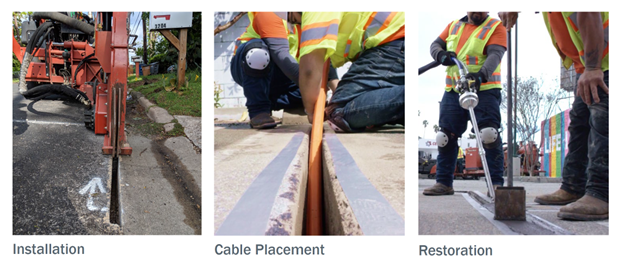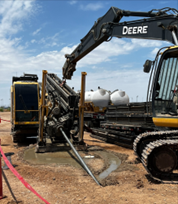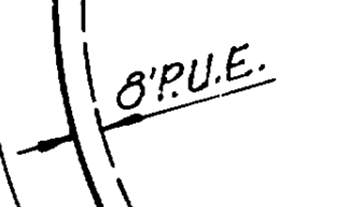Construction
Construction work is happening all over Mesa in our Rights of Way and Public Utility Easements. Contractors are using different methods like horizontal directional drilling, trenching, tunneling, and micro trenching to put in conduits.
These conduits hold cables for things like the internet. Once the conduits are in, contractors blow the cables through them using strong air pressure and connect the network. Read more about our required construction standards on the Right of Way Management Group webpage.
Usually, the construction won't last more than a couple of weeks. But it's best to ask your internet provider for the exact schedule in your area. Sometimes things like bad weather or broken equipment can delay the work.
Utility companies are not required by law to co-locate their infrastructure with other providers, which means that even after one company is finished and the property is restored, other companies can come through the same area and start the process again.
Below is an example of micro-trench construction

Below is an example of horizontal directional drilling

Conduits, fiber optic cables, vaults, and equipment are designed and constructed within rights-of-way and easements.
Rights of Way (ROW)
ROW is land that is owned or managed by the City, intended for public purposes and access. Within this area, the City plans where things like water, electricity, gas, internet, drainage systems, sidewalks, plants, traffic lights, street lamps, flood protection, walkways, and roads will go. The exact borders of this land can be different depending on where you are.
You can locate ROW areas by visiting the Maricopa County Assesor's Office Parcel Viewer map and selecting “Parcels."
Public Utility Easements (PUE)
A PUE (Public Utility Easement) allows private utility companies to use private property to build and maintain their infrastructure. It's one of the most common permissions found on properties, including residential. It's rare to own property without any easements. The size and exact boundaries of a PUE can vary depending on where you are. You can usually find a list of these permissions, including the PUE, in a property's Title Report under the "Schedule B" section. Information about easements might also be in recorded subdivision plats and property deeds. You can check these by visiting the Maricopa County Assesor's Office Parcel Viewer map and selecting “Parcels."
Here's a simple drawing that shows what a PUE might look like on a map of a subdivision plat. 
Responsibilities for Fixing Property Damage
Should the contractor cause any damage to the surface or subsurface of ROW, PUEs, or any third-party properties, the contractor is required to restore the area. At their own cost, they must carry out repairs and restorations to the City’s satisfaction, ensuring the affected area is returned to a state that closely matches its original condition.
Notifications
As per Mesa City Code, internet companies must tell people beforehand if they're going to do construction near their homes. They'll give notice either by leaving a note at your door or sending a letter. This notice will have the company's name, contact details, who's doing the work, when they plan to do it, and what they'll be doing. Also, you might see big green signs at the entrances of your neighborhood, letting you know that construction will start soon or is already happening.
Markings
Blue, purple, green, orange, yellow, white and/or pink paint markings will be sprayed on the ground several weeks before construction begins. The paint tells contractors where existing underground utility lines are located so that they can be avoided when digging. The different colored paint marks are not only required by law, but also help prevent serious and fatal injuries and protect vital infrastructure. Locators most commonly use a water-based paint that will fade over time.
Why utility-location marks are important
Temporary Traffic Control
During construction, you may notice temporary parking and lane restrictions. The traffic barricading company will put up "No Parking" signs at least two days before construction starts to keep you informed. These signs will indicate when parking isn't allowed, typically from Monday to Friday, except on holidays. We know parking matters to you, and we aim to lessen any disruptions. If construction carries on through the weekend, the barricade company will update the signs beforehand. See interactive map below.
Noise
Construction staging, activity, and cleanup may cause additional noise; however the noise is required to stay within the limits of Mesa’s noise ordinances. City’s noise ordinance, including excessive and prohibited noise levels.
